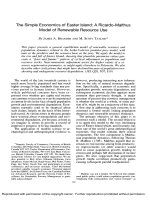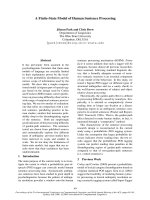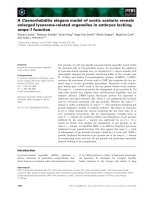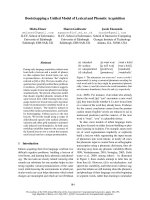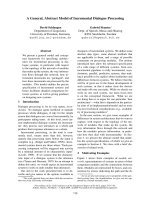A hubel wiesel model of early concept generalization based on local correlation of input features
Bạn đang xem bản rút gọn của tài liệu. Xem và tải ngay bản đầy đủ của tài liệu tại đây (2.1 MB, 97 trang )
A Hubel Wiesel Model of Early Concept
Generalization Based on Local Correlation of
Input Features
SEPIDEH SADEGHI
(B. Sc., Iran University of Science & Technology)
A THESIS SUBMITTED
FOR THE DEGREE OF MASTER OF ENGINEERING
DEPARTMENT OF ELECTRICAL AND COMPUTER
ENGINEERING
NATIONAL UNIVERSITY OF SINGAPORE
2011
ii
iii
Acknowledgements
I would like to express my genuine gratitude to Dr. Kiruthika Ramanathan, from Data Storage
Institute (D.S.I), for her support and encouragement in the research and the preparation of this
thesis. Through her leadership, insightful advice and excellent judgment, I was able to increase
my basic knowledge of analysis and commit to research in the area of my interest.
I would like to express my gratitude to Professor Chong Tow Chong - my supervisor from
National University of Singapore (N.U.S) -, and Dr. Shi Luping - my supervisor from D.S.I - for
reviewing the progress of my project. I am also thankful to Singapore International Graduate
Award (S.I.N.G.A) and D.S.I for providing me such wonderful project opportunity and the
financial support throughout the course of the project. Appreciation is also extended to Electrical
and Computer Engineering department at National University of Singapore.
I also thank all my friends from N.U.S and D.S.I for the excellent company they gave during the
course of the project. I would also like to thank all my friends in Singapore who made my stay a
wonderful experience.
Last, but not least, I am grateful to my parents, and sisters, whose devotion, support, and
encouragement have inspired me and been my source of motivation for graduate school.
iv
v
Table of Contents
1. Introduction 1
1.1 On Concepts and Generalization 1
1.2 Background and Related Studies 2
1.2.1 Concept acquisition and generalization 2
1.2.2 Hubel Wiesel models of memory 4
1.2.3 Hubel Wiesel models of concept representation 6
1.3 Objective of the Thesis 7
1.4 Summary of the Model 8
1.5 Organization of the Thesis 11
2. Methodology 14
2.1 System Architecture 15
2.1.1 Architecture 15
2.1.2 Bottom up hierarchical learning 19
2.2 Hypothesis 22
2.3 Local Correlation Algorithm 27
2.3.1 Marking features/modules as general or specific 31
vi
2.3.2 Generalization 33
2.3.2.1 Input management 33
2.3.2.2 Prioritization 35
2.3.3 The effect of local correlation model on the categorization of single modules 36
3. Results and Discussions 39
3.1 Two Types of Input Data 39
3.2 Generalization 46
3.3 Local Correlation Operations and Computational Parameters 49
3.4 Building Hierarchical Structures of Data 55
4. Conclusion 61
4.2 Concluding Remarks 61
4.3 Future Works 63
Bibliography 66
Appendix A-1: Dataset A - List of Entities 73
Appendix A-2: Dataset B - List of Entities 75
Appendix A-3: Dataset C - List of Entities 77
vii
A Hubel Wiesel Model of Early Concept Generalization Based on
Local Correlation of Input Features
Sepideh Sadeghi
Submitted on JAN 21, 2011
In Partial Fulfillment of the Requirements for the
Degree of Master of Engineering in Electrical and Computer Engineering
Abstract
Hubel Wiesel models, successful in visual processing algorithms, have only recently been used
in conceptual representation. Despite the biological plausibility of a Hubel-Wiesel like
architecture for conceptual memory and encouraging preliminary results, there is no
implementation of how inputs at each layer of the hierarchy should be integrated for processing
by a given module, based on the correlation of the features. If we assume that the brain uses a
unique Hubel Wiesel like architecture to represent the input information of any modality, it is
important to account for the local correlation of conceptual inputs as an equivalent to the existing
local correlation of visual inputs in the visual counterpart models. However, there is no intuitive
local correlation among the conceptual inputs. The key contribution of this thesis is the proposal
of an input integration framework that accounts for the local correlation of the conceptual inputs
in a Hubel Wiesel like architecture to facilitate the achievement of broad and coherent concept
categories at the top of the hierarchy. The building blocks of our model are two algorithms: 1)
Bottom-up hierarchical learning algorithm, and 2) Input integration framework. The first
viii
algorithm handles the process of categorization in a modular and hierarchical manner that
benefits from competitive unsupervised learning in its modules. The second algorithm consists of
a set of operations over the input features or modules to weigh them as general or specific to
specify how they should be locally correlated within the modules of the hierarchy. Furthermore,
the input integration framework interferes with the process of similarity measurement applied by
the first algorithm such that, high-weighted features would count more than the low-weighted
features towards the similarity of conceptual patterns. Simulation results on benchmark data
admit that implementing the proposed input integration framework facilitates the achievement of
the broadest coherent distinctions of conceptual patterns. Achieving such categorizations is a
quality that our model shares with the process of early concept generalization. Finally, we
applied our proposed model of early concept generalization iteratively over two sets of data,
which resulted in the generation of finer grained categorizations, similar to progressive
differentiation. Based on our results, we conclude that the model can be used to explain how
humans intuitively fit a hierarchical representation for any kind of data.
Keywords: Early Concept Generalization, Hubel Wiesel Model, Local Correlation of Inputs,
Categorization, General Features, Specific Features.
Thesis Supervisors:
1. Prof. Chong Tow Chong, National University of Singapore, and Singapore University of
Technology and Design.
2. Dr. Shi Luping, Senior Scientist, Data Storage Institute.
ix
x
List of Tables
Table 3.1 Features and their
values sorted in a decreasing order…………………………….43
Table 3.2 Features and their weights…………………………………………………………….44
Table 3.3 Datasets used in the simulations………………………………………………………46
Table 3.4 The effect of growth threshold on the quality of categorization biasing, using max-
weight operation over dataset B (7 modules at the bottom layer)……………………….……….52
Table 3.5 The effect of growth threshold on the quality of categorization biasing, using sum-
weights operation over dataset B (7 modules at the bottom layer)……………………….…… 52
Table 3.6 Summary of the experiments… …………………………………………………… 54
Table 4.1 The effect of decreasing growth threshold on the categorization of the local correlation
model …………………………………………………………………………………………….63
xi
List of Figures
Figure 1.1 The flow chart of the bottom-up algorithm - Hubel Wiesel model of early concept
generalization. The highlighted rectangles demonstrate local correlations operations………….10
Figure 1.2 The flow chart of the top-down algorithm – to model progressive differentiation… 11
Figure 2.1 Hierarchical structure of the learning algorithm when the data includes 12 features 18
Figure 2.2 (a) Inputs and outputs to a single module m
k,i
,
(b) the concatenation of information
from the child modules of the hierarchy to generate inputs for the parent module…………… 21
Figure 2.3 General features versus specific features…………………………………………….23
Figure 2.4 Bug-like patterns used in [15], and the corresponding labeling rules for the
categorization task……………………………………………………………………………….25
Figure 2.5 Inputs and outputs of the child modules. The outputs of child modules are the inputs
to the parent module…………………………………………………………………………… 30
Figure 2.6 (a) A set of patterns and their corresponding features, (b) features sorted in non-
increasing order on the basis of their
values, (c) features are marked according to the value of
………………………………………………………………………………………………… 32
Figure 2.7 (a) The use of general, specific and an intermediate features (low weighted general
features) in each module when the number of features per module is odd, (b) the use of general
and specific features when the number of features per module is even………………………….35
Figure 2.8 (a) ‘canary’ as an animal is mistakenly grouped with ‘pine’ as a plant when
prioritization and input management are not included, (b) substituting the specific feature ‘walk’
with the general feature ‘root’ fixes the categorization due to inclusion of input management, (c)
xii
canary’ as animal is mistakenly grouped with plants when prioritization and input management
are not included, (d) applying prioritization, fixes categorization to be coherent……………….37
Figure 3.1 single features divide the pattern space into two groups…………………………… 40
Figure 3.2 Unique structured data. (1) Categorization of the patterns on the basis of
must be
similar to the categorization on the basis of
, or (2) only one of the previous categories built on
the basis of
is divided on the basis of
. …………………………………………………… 41
Figure 3.3 Input patterns…………………………………………………………………………43
Figure 3.4 The hierarchical structure of data in Figure 3.3 when features: ‘Is blue’ and ‘Is
orange’ are disregarded ……………………………………………… ……………………… 44
Figure 3.5 The hierarchical structure of the right branch in Figure 3.4 when the categorization is
biased on the basis of shape…………………………………………………………………… 45
Figure 3.6 The hierarchical structure of the right branch in Figure 3.4 when the categorization is
biased on the basis of color………………………………………………………………………45
Figure 3.7 (a) the most frequent/common outcome categorization of dataset A by local
correlation model – successful categorization, (b) Illustrating the probability of successful
categorization over set A, being obtained in a set of trials using sum-weights, max-weight and no
correlation model under different hierarchies of learning. Each probability demonstrates the ratio
of the number successful categorizations obtained over 10 trials carried out using a specific
correlation operation and under specific hierarchy of learning………………………………….48
Figure 3.8 (a) The most frequent categorization of dataset C by local correlation model –
successful categorization, (b) Illustrating the probability of successful categorization over set C,
being obtained in a set of trials using sum-weights and max-weight operations under different
hierarchies of learning. Each probability is computed in the same way as explained in (3.7 b) 49
xiii
Figure 3.9 The probability of categorization in Figure 3.7(a) over dataset A. A comparison of
sum-weights and max-weight under different growth thresholds (8 learning modules at the
bottom layer)…………………………………………………… …………………………… 51
Figure 3.10 The probability of categorization in Figure 3.8(a) over dataset C. using max-weight
operation under different growth thresholds in different hierarchical structures……………… 51
Figure 3.11 Hierarchical structure of dataset A………………………………………………….57
Figure 3.12 Hierarchical structure of dataset C………………………………………………….58
Figure 3.13 Temporal (cycle) and spatial (hierarchy) relationships of seasons and months…….58
Figure 3.14 (a) Less abstraction in the categorization, (b) higher levels of abstraction in the
categorization due to the use of the non-leaf concept ‘~ mammals’…………………………….59
xiv
List of Abbreviations
SOM …………………………………………………………………………Self Organizing Map
GSOM …………………………………………………………… Growing Self Organizing Map
xv
List of Symbols
…………………………………………………………… ith input pattern in the input data set
…………………………………… jth feature in an input vector or in a neuron weight vector
……………………………………………………… ………jth feature in the ith input pattern
…………………………………………….Activation of the ith neuron in the jth
module in response to the kth input pattern
……………………………………… Training matrix for the module number i
m
k,i
……………………………………… ……………ith module in the kth level of the hierarchy
………………………………………………………………… Presence number of feature
………………………………………………… Weight of the jth input feature or module
τ Ratio of the number general features
to the number of specific features input to each module at the bottom most layer of the hierarchy
………………………………………… Ratio of the number of general modules to the number
of specific modules input to each module at the intermediate or top most layers of the hierarchy
Q…………………………… Queue of inputs (features or modules) for level k of the hierarchy
G Queue of general inputs (features or modules) for level k of the hierarchy, used for marking
S …Queue of specific inputs (features or modules) for level k of the hierarchy, used for marking
……………….Capacity of a module in terms of the number of features it may receive
nChild Capacity of a module in terms of the number of child modules it may receive
nModule(i)………………………………………………………… Number of modules at level i
xvi
nLevel…………………………… Level number. It equals to one at the bottom of the
hierarchy and increases moving upwards in the hierarchy
…………………………………………… Number of specific features available in S
……………………………………………….……Number of general features in a module
………………………………………… Number of specific features in a module
Max-weight One implementation of the local correlation algorithm
Sum-weights………………………………One implementation of the local correlation algorithm
Ceiling(i)…………………… ………… Function that returns the smallest integer that follows i
Floor(i)………………………… …… Function that returns the largest integer that precedes i
xvii
1
Chapter 1
Introduction
1.1 On Concepts and Generalization
Concepts are the most fundamental constructs in theories of the mind. In
psychology, a wide variety of questionable definitions of concepts exist such as
“should concepts be thought of as bundles of features, or do they embody mental
theories?” or “are concepts mental representations, or might they be abstract
entities?” [1]. In our thesis, we define a concept as a mental representation which
partially corresponds to the words of the language. We further assume that a
concept can be defined as a set of typical features [2].
We adopt the following definitions.
1. Concept categorization is the process by which the concepts are
differentiated.
2. Concept generalization is the categorization of concepts into less specific and
broader categories.
3. Early concept generalization is the early stage of progressive differentiation
of concepts [3], in which children acquire broad semantic distinctions.
2
Concept generalization is one of the primary tasks of human cognition.
Generalization of new concepts (conceptual patterns) based on prior features
(conceptual features) leads to categorization judgments that can be used for
induction. For example, given that an entity has certain features including: four
legs, two eyes, two ears, skin, and ability to move, one may generalize that the
entity (specific concept) is an animal instance (general concept). Therefore, the
process of generalization leads to the category judgments (being an animal
instance) about the object. Based on the category to which the object belongs, we
can induce some hidden properties of the concept. For example, given that a
conceptual entity belongs to the category of animals, we can induce that the entity
eats, drinks and sleeps.
In recent years, research in computational cognitive science has served to reveal
much about the process of concept generalization [3-5].
1.2 Background and Related Studies
This section is divided into two sub-sections. The first part discusses the state of
art in the field of concept acquisition and generalization, and the second part
describes research in the field of Hubel Wiesel models of memory.
1.2.1 Concept acquisition and generalization
The idea of feature based concept acquisition and generalization has been well
studied in the psychological literature. Vygotsky [6], Inhelder and Piaget [7] first
3
proposed that the representation of categories develop from immature
representations that are based on accidental features (appearance similarities).
Recent theoretical and practical developments in the study of mature
categorization indicate that generalization is grounded on perceptual mechanisms
capable of detecting multiple similarities [3, 8-10].
Tests such as the trial task [11] show the role of feature similarity in the
generation of categorization. Further to this, works by McClelland and Rogers [3],
Rumelhart [9, 12] etc. show evidence for bottom up acquisition of concepts in
memory. Sloutsky [13-15] discuss how children group concepts based on, not
just one, but multiple similarities and how such multiple similarities tap the fact
that basic level categories have correlated structures (or features). The correlation
of features is also discussed in McClelland and Rogers [3] where they refute
Quillian‟s classic model [16] of a semantic hierarchy where concepts are stored in
a hierarchy progressing from specific to general categories. They argue that
general properties of objects should be more strongly bound to more specific
properties than to the object itself. Furthermore, McClelland and Rogers argue
that information should be stored at the individual concept level rather than at the
super ordinate category level. Only under this condition, properties can be shared
by many items. They cite the following example: Many plants have leaves, but
not all do – pine trees have needles. If we store „has leaves‟ with all plants, then
we must somehow ensure that it is negated for those plants that do not have
leaves. If instead we store it only with plants that have leaves, we cannot exploit
the generalization. McClelland and Rogers counter propose a parallel distributed
4
processing (PDP) model, which is based on back propagation, and test it using 21
concepts, including trees, flowers, fish, birds and animals. Their network showed
progressive differentiation. Progressive differentiation phenomenon refers to the
fact that children acquire broader semantic distinctions earlier than more fine-
grained distinctions [5]. Our model falls under the umbrella of bottom-up
architectures, but is bio-inspired (within a Hubel Wiesel architecture) and
explains categorization and progressive differentiation, accounting for local
correlation of input features.
1.2.2 Hubel Wiesel models of memory
It is well known that the cortical system is organized in a hierarchy and that some
regions are hierarchically above others. Further to this, Mountcastle [17, 18]
showed that the brain is a modular structure and the cortical column is its
fundamental unit. A hierarchical architecture has been found in various parts of
the neocortex including the visual cortex [19-23], auditory cortex [24, 25] and the
somato-sensory cortex [26, 27]. In addition to this, neurons in the higher levels of
the visual cortex represent more complex features with neurons in the IT
representing objects or object parts [28, 29].
On the spectrum of cognitively inspired architectures, Hubel Wiesel models are
designed for object recognition. Beginning from the Neocognitron [30, 31] to
HMAX [19, 20, 32, 33], SEEMORE [34], various bio inspired hierarchical
models has been used for object recognition and categorization. The primary idea
of these models is a hierarchy of simple (S) and complex (C) cells, inspired by
5
visual cortex cells. For example, in visual cortex each S cell responds selectively
to particular features in the receptive field. Therefore, the S cell is a feature
extractor which, at the lower levels, extracts local features and, at the higher
layers, extracts global features. C cells allow for positional errors in the features.
Therefore, a C cell is more invariant to shift in position of the input pattern. The
combination of S cells and C cells, whose signals propagate up the hierarchy
allows for scale and position invariant object recognition.
The Neocognitron [30, 31] applies the principles of hierarchical S and C cells to
achieve deformation resistant character recognition. Neocognitron uses a
competitive network to implement the S and C cells, following a winner-take all
update mechanism. HMAX is a related model based on a quantitative theory of
the ventral stream of the visual cortex. Similar to Neocognitron, HMAX uses a
combination of supervised and unsupervised learning to perform object
categorization, but uses Gabor filers to extract primitive features. HMAX has
been tested on benchmark image sets such as the Caltech 101 and the Streetscenes
database. Lecun et al [35] have implemented object categorization using multi
layered convoluted networks. All these mentioned models are deep hierarchical
networks that are trained using back propagation. Wallis and Rolls [36-38]
showed that increasing the number of hierarchical levels leads to an increase in
invariance and object selectivity. Wersing and Koener [39] discuss the effects of
different transfer functions over the sparseness of the data distribution in an
unsupervised hierarchical network. Wolf et al [40] discuss alternative hierarchical
6
architectures for visual models and test their strategies on the Caltech 101
database.
1.2.3 Hubel Wiesel models of concept representation
In a recent work Ramanathan et al [41] have extended Hubel Wiesel models of
the visual cortex [20, 32] to model concept representation. The resulting
architecture, trained using competitive learning units arranged in a modular,
hierarchical fashion, shares some properties with the Parallel Distributed
Processing (PDP) model of semantic cognition [3]. To our knowledge, this is the
first implementation of a Hubel Wiesel approach to non- natural medium such as
text, and has attempted to model hierarchical representation of keywords to form
concepts.
Their model exploits the S and C cell configuration of Hubel Wiesel models by
implementing a bottom up, modular, hierarchical structure of concept acquisition
and representation, which lays a possible framework for how concepts are
represented in the cortex.
However the architecture of this model is similar to that of visual Hubel Wiesel
models, there‟s still a gap between the process of feature extraction and
integration in their model and the one in its counterpart visual models. In the
existing visual models, small patches of the picture are input to the S cells where
neighboring S cells extract neighboring patches of the picture. Then, C cells
integrate several neighboring S cells. The neighborhood of the visual inputs
7
within small patches extracted by S cells and the neighborhood of the small
patches integrated in C cells explain a coherent a local correlation of inputs
preserved all over the hierarchy. On the other hand, in the conceptual Hubel
Wiesel model proposed by Ramanathan et al [41], there is no provision to account
for the local correlation of inputs and how it should be preserved through the
hierarchy.
1.3 Objectives of the Thesis
The objective of this dissertation is to capture the quality of early concept
generalization and progressive differentiation of concepts within a Hubel Wiesel
architecture that accounts for local correlation of inputs and category coherence.
Category coherence [42] refers to the quality of a category being natural, intuitive
and useful for inductive inferences. We assume that preserving the natural
correlation of inputs through the hierarchy is the necessary condition for the
achievement of coherent categories at the top level of the hierarchy. Definition of
such correlations in visual models is intuitive - spatial neighborhood -, while
being a challenge in conceptual models. If we assume that the brain uses a
hierarchical Hubel Wiesel like architecture to represent concepts, it is important to
account for this local correlation factor. Moreover, it is likely that the
categorization results at the top level of the hierarchy are dependent on the input
integration framework of the hierarchy. Hence, we argue one possible metric
based on which a local correlation model among conceptual features can be
8
achieved. Then, we propose an input integration framework to maintain such
correlation through hierarchy.
Interestingly, it was observed that the proposed correlation model along with its
corresponding input integration framework succeed to facilitate the achievement
of coherent categorization - which admits our prior assumption in this regard. The
proposed model not only effectively captures coherent categorization but also
ensures revealing of the broadest differentiation of its conceptual inputs. Based on
our literature survey, revealing the broadest differentiation is one of the qualities
of early concept generalization. Therefore, our model shares this quality with
early concept generalization. The flow chart of our model of early concept
generalization is presented in Figure 1.1. Based on our knowledge about concept
generalization, first it facilitates acquiring of broad distinctions and only as a
matter of time leads to acquiring of the finer distinctions. This flow is called
progressive differentiation of concepts which can also be captured by our model.
The top-down iterative use of the proposed model over a data set and its
corresponding subsets (broad categories generated by the model) results in
creation of finer categories, similar to progressive differentiation. The flow chart
of this top-down algorithm is presented in Figure 1.2.
1.4 Summary of the Model
Figure 1.1 illustrates the flow chart of the bottom-up algorithm for Hubel Wiesel
model of early concept generalization proposed in this work. The details of the
